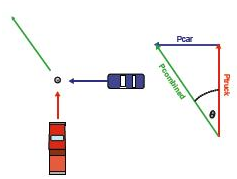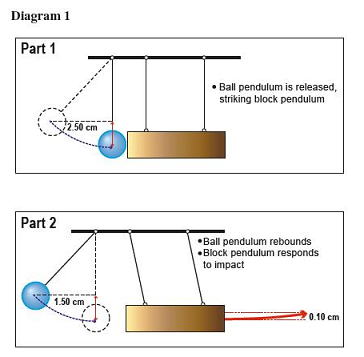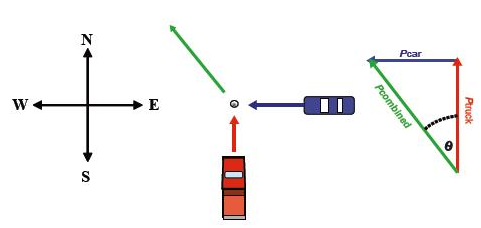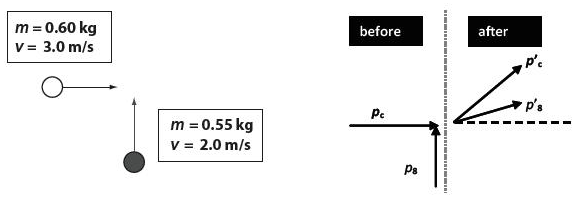PHYSICS ASSIGNMENT -
Part One: Linear Collisions and Conservation of Momentum
1. Using the numbers provided in the tables below, fill in the missing values then answer the questions that follow.
|
Object
|
Mass (kg)
|
Initial v (m/s)
|
Final v (m/s)
|
Change in v (m/s)
|
Initial momentum (kg·m/s)
|
Final momentum (kg·m/s)
|
Change in momentum (kg·m/s)
|
|
blue
|
2.00
|
6.00
|
2.00
|
|
|
|
|
|
green
|
4.00
|
0.00
|
2.00
|
|
|
|
|
|
Object
|
Mass (kg)
|
Initial v (m/s)
|
Final v (m/s)
|
Change in v (m/s)
|
Initial momentum (kg·m/s)
|
Final momentum (kg·m/s)
|
Change in momentum (kg·m/s)
|
|
blue
|
2.00
|
6.00
|
1.50
|
|
|
|
|
|
green
|
6.00
|
3.00
|
4.50
|
|
|
|
|
a. Is there a relationship between the change in velocity of the blue mass and the green mass? If yes, describe the relationship.
b. Is there a relationship between the change in momentums of the blue mass and the green mass? If yes, describe the relationship.
2. If the change in momentum of one object is exactly equal but opposite to the change in momentum of another object, what does that indicate about the total momentum of the system?
3. Object A, with a mass of 2.0 kg, is travelling to the right at 15.0 m/s. Object B, with a mass of 12.5 kg, is also travelling at 15.0 m/s, but to the left. If the two objects stick together upon impact, what is the final velocity of the system?
4. A 250-g firecracker explodes into two pieces. The first piece has a mass of 97 g and flies off to the right at 16 m/s. What is the velocity of the second piece?
5. Consider the following problem and its solution when solving the problems which follow.
Object A, initially travelling to the right, collides with object B, which is at rest. Object B has more mass than object A. After the collision, object A moves back to the left and object B moves to the right. Is this collision possible?

Using sign convention, momentum is positive before the collision (+ plus 0 = +). After the collision, A has a negative momentum and B has a positive momentum. The initial momentum of the system is positive. The final momentum of A is negative. The final momentum of B is positive. If magnitude of momentum of B is larger than magnitude of momentum of A, then the net momentum is positive so that the direction of momentum is the same as before the collision, so that the collision is possible.
a. Object A, initially travelling to the right, collides with object B, which is at rest. After the collision, object A moves back to the left and object B remains at rest. Neglecting friction, is this possible? Explain.
b. An object is travelling to the right and collides with another object that is at rest. After the collision, both objects travel to the right, but at different speeds. Neglecting friction, is this possible? Explain.
6. A car collides with a truck at an intersection in a perfectly inelastic collision as shown below. The length and angle of the skid-marks after the collision is used to calculate the momentum of the system and using the law of conservation of momentum and appropriate vector techniques, the momentum and speed of the car and truck before the collision are determined to see if either driver was speeding.

Three students considered the collision and came up with their own assumptions about the validity of the solution. These assumptions could be grounds for reasonable doubt if there was a court case against the car's driver due to damages caused by the collision. Read the three possible student answers below and decide whether their statements are true or false. Explain the reason for your decision.
a. Student 1 - The law of conservation of momentum is a scientific law and therefore it always works."
b. Student 2 - Because so much energy was lost, the driver of the car might not have been speeding, but could have been going slower than the calculations indicate.
c. Student 3 - This system isn't isolated so kinetic energy is lost, but you can still calculate the speed at impact.
Part Two: Kinetic Energy and Collisions
1. In the following charts you are given the first few numbers. Enter these values into the simulation then determine the missing quantities. Ensure the elasticity value is 100%.
|
e = 100
|
|
|
|
|
|
|
|
|
object
|
Mass (kg)
|
Initial v (m/s)
|
Final v (m/s)
|
Initial momentum (kg·m/s)
|
Final momentum (kg·m/s)
|
Initial kinetic energy
|
Final kinetic energy
|
|
blue
|
5.0
|
+ 8.0
|
0.0
|
|
|
|
|
|
green
|
5.0
|
0.0
|
+ 8.0
|
|
|
|
|
|
total
|
|
|
|
|
|
|
|
|
e = 100
|
|
|
|
|
|
|
|
|
object
|
Mass (kg)
|
Initial v (m/s)
|
Final v (m/s)
|
Initial momentum (kg·m/s)
|
Final momentum (kg·m/s)
|
Initial kinetic energy
|
Final kinetic energy
|
|
blue
|
5.00
|
+6.00
|
- 1.00
|
|
|
|
|
|
green
|
7.00
|
0.0
|
+5.00
|
|
|
|
|
|
total
|
|
|
|
|
|
|
|
2. Answer the following questions using the data collected in the collision tables from question one.
a. Is momentum conserved in each collision?
b. Is kinetic energy conserved in each collision?
3. With elasticity values of 100%, 80%, and 60% use the simulation to find total Ek initial and total Ek final and complete the data table including the percentage of loss of kinetic energy for each collision.
|
Collision
|
e%
|
Initial kinetic energy (J)
|
Final kinetic energy (J)
|
Per cent loss in kinetic energy
|
|
1
|
100
|
|
|
|
|
2
|
80
|
|
|
|
|
3
|
60
|
|
|
|
4. Using the results from the data table from question three above, compare the percentage of total kinetic energy lost during each collision to the value of e. What is the relationship between percentage of loss in kinetic energy and e?
5. A ballistic pendulum experiment is performed as shown in the diagrams below. The ball has a mass of 0.200 kg and the wooden block has a mass of 1.000 kg. Use the data in the diagrams to do appropriate calculations to determine if the collision is elastic or inelastic. (Hint: It should be possible to draw a conclusion without calculating any velocities.)

6. A new communications satellite is being sent into space. The rocket carrying the satellite has a mass of 2.04 x 106 kg. The engines expel 3.7 x 103 kg of exhaust gas during the first second of liftoff giving the rocket a velocity of 5.7 m/s [up]. At what velocity is the exhaust gas leaving the rocket engines? Ignore the change is mass due to the fuel being consumed. The exhaust gas needed to counteract the force of gravity has already been accounted for and should not be part of this calculation. Show all calculations.
7. Show how Ft = m?v is related to Newton's second law of motion.
Part Three: Analyzing Non-Linear Collisions
1. A car with a mass of 1400 kg is westbound at 50 km/h. It collides at an intersection with a northbound truck having a mass of 2000 kg and travelling at 40 km/h. What is the initial common velocity of the car and truck immediately after the collision if they have an inelastic collision? For this question, a diagram is drawn for you. (You will find that drawing such a diagram will often be useful in solving two dimensional problems.)

2. A police car with a mass of 1400 kg is headed west at 60 km/h when it has an inelastic collision with a southbound 2000-kg ambulance. The wreckage ended up travelling at 45 km/h at 236o. What was the initial speed of the ambulance?
3. A billiard cue ball with a mass of 0.60 kg and an eight ball with a mass of 0.55 kg are rolled toward each other. The cue ball has a velocity of 3.0 m/s at 0o and the eight ball has a velocity of 2.0 m/s at 90o. After the collision, the cue ball moves off at a velocity of 2.0 m/s at 40o.

a. Determine the velocity of the eight ball.
b. Perform appropriate calculations to determine whether or not the collision is elastic. State your conclusion.